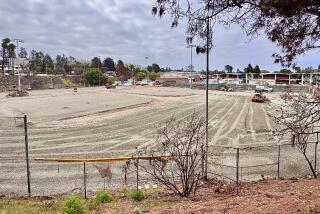SAN JUAN CAPISTRANO : Future Beckons Site With Long Past
- Share via
Like so much of this two-century-old community, the 10-acre site of old Capistrano Union High School oozes history.
Sandwiched between Camino Capistrano, which was built in 1913 as State Highway 101, and El Camino Real, the ancient road linking the missions, the property sits across the street from one of the county’s oldest historical sites, Mission San Juan Capistrano.
While the high school closed in 1964 and now serves as a continuation school and adult education center, its surrounding ball fields, basketball and tennis courts remain a gathering place. But the city has much bigger plans for it.
Under terms of a 4-year-old project that is nearing fruition, the Capistrano Unified School District and the city’s Redevelopment Agency have put together a trade that will enable the city to include the old campus in a $5-million civic center and city hall.
In return, the school district will get 10 acres of city property in a still undetermined area and a new gymnasium and swimming complex at Capistrano Valley High School in Mission Viejo, paid for by the Redevelopment Agency.
Both sides have applauded the agreement.
The growing city gets a much- needed new city hall and cultural center, and Capistrano Valley High School, a school with a rich athletic tradition, gets its long-awaited new gym and pool.
All this for a 10-acre parcel the school district bought for $10 from the Union Bank & Trust Co. of Los Angeles in 1921.
“It’s one of those things where everybody won, a win-win situation,” said William Dawson, assistant superintendent of the school district.
The first stage of the agreement is now under way. Bids are being sought for the gym with hopes for a ground breaking this summer. Meanwhile, the IBI Group, a Newport Beach architectural firm, is finishing its master plan for the civic center and is expected to submit it to the city in June or July.
The city has promised to respect the historical integrity of the property and will incorporate the Art Deco lines of the old high school into its new plan.
“This is not the type of city where you just go in and bulldoze everything and build a new civic center,” said Cassandra Walker, the manager of the city’s Redevelopment Agency. “We understand the value of preserving what is here.”
Among the amenities the city plans to save are a stone wall that encircles much of the property, which was built by the Works Progress Administration in 1936; the poured-in-place concrete school building built in 1939, and another school structure with a roof shaped by a series of beams called a wood bow-truss system.
And those are the relatively recent additions. There’s a brick tiled zanja , the Spanish word for aqueduct or channel, running across the property. Historians believe that it helped transport water for domestic use and irrigation from nearby Trabuco Creek to the mission.
More to Read
Sign up for Essential California
The most important California stories and recommendations in your inbox every morning.
You may occasionally receive promotional content from the Los Angeles Times.













